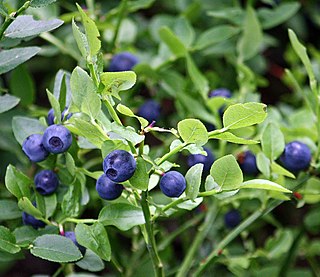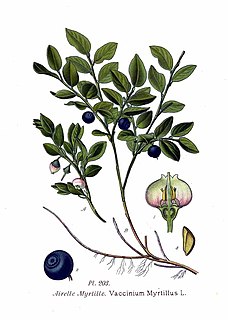
A berry is a small, pulpy, and often edible fruit. Typically, berries are juicy, rounded, brightly colored, sweet, sour or tart, and do not have a stone or pit, although many pips or seeds may be present. Common examples are strawberries, raspberries, blueberries, blackberries, red currants, white currants and blackcurrants. In Britain, soft fruit is a horticultural term for such fruits.

Vaccinium is a common and widespread genus of shrubs or dwarf shrubs in the heath family (Ericaceae). The fruits of many species are eaten by humans and some are of commercial importance, including the cranberry, blueberry, bilberry (whortleberry), lingonberry (cowberry), and huckleberry. Like many other ericaceous plants, they are generally restricted to acidic soils.

Bilberries, or occasionally European blueberries, are a primarily Eurasian species of low-growing shrubs in the genus Vaccinium, bearing edible, dark blue berries. The species most often referred to is Vaccinium myrtillus L., but there are several other closely related species.

Cercis canadensis, the eastern redbud, is a large deciduous shrub or small tree, native to eastern North America from southern Michigan south to central Mexico, east to New Jersey. Species thrive as far west as California and as far north as southern Ontario, roughly corresponding to USDA hardiness zone 6b. It is the state tree of Oklahoma.

A beekeeper is a person who keeps honey bees.

Vaccinium virgatum is a species of blueberry native to the Southeastern United States, from North Carolina south to Florida and west to Texas.

Fouquieria splendens is a plant indigenous to the Sonoran Desert and Chihuahuan Desert in the Southwestern United States, and northern Mexico.

Osmia ribifloris, one of several species referred to as a blueberry bee, is a megachilid bee native to western North America, including Oregon, California, Nevada, Utah, Arizona, New Mexico, Texas and northern Mexico. This solitary bee normally gathers pollen from plants in the family Ericaceae, with manzanita, Arctostaphylos sp. being a preferred host in the wild. It will pollinate blueberries, and is sometimes used commercially for this purpose.

Vaccinium myrtillus or European blueberry is a species of shrub with edible fruit of blue color, commonly called "bilberry", "wimberry", "whortleberry". It has much in common with the American blueberry. It is more precisely called common bilberry or blue whortleberry, to distinguish it from other Vaccinium relatives. Regional names include blaeberry, urts or hurts, hurtleberry, huckleberry, myrtleberry, wimberry, whinberry, winberry, blueberry, and fraughan. Chromosome count is 2n =24.

Vaccinium angustifolium, commonly known as the wild lowbush blueberry, is a species of blueberry native to eastern and central Canada and the northeastern United States, growing as far south as the Great Smoky Mountains and west to the Great Lakes region.

Vaccinium corymbosum, the northern highbush blueberry, is a North American species of blueberry which has become a food crop of significant economic importance. It is native to eastern Canada and the eastern and southern United States, from Ontario east to Nova Scotia and south as far as Florida and eastern Texas. It is also naturalized in other places: Europe, Japan, New Zealand, the Pacific Northwest of North America, etc. Other common names include blue huckleberry, tall huckleberry, swamp huckleberry, high blueberry, and swamp blueberry.

Habropoda laboriosa, the southeastern blueberry bee, is a bee in the family Apidae.

Live on Blueberry Hill is a bootleg recording of English rock group Led Zeppelin's performance at the Los Angeles Forum on September 4, 1970, which took place during their summer 1970 North American Tour.

Vaccinium stamineum, commonly known as deerberry, tall deerberry, squaw huckleberry, highbush huckleberry, buckberry, and southern gooseberry, is a species of flowering plant in the heath family. It is native to North America, including Ontario, the eastern and central United States, and parts of Mexico. It is most common in the southeastern United States.

Blueberries are perennial flowering plants with blue or purple berries. They are classified in the section Cyanococcus within the genus Vaccinium. Vaccinium also includes cranberries, bilberries, huckleberries and Madeira blueberries. Commercial blueberries—both wild (lowbush) and cultivated (highbush)—are all native to North America. The highbush varieties were introduced into Europe during the 1930s.

Vaccinium pallidum is a species of flowering plant in the heath family known by the common names hillside blueberry, Blue Ridge blueberry, late lowbush blueberry, and early lowbush blueberry. It is native to central Canada (Ontario) and the central and eastern United States plus the Ozarks of Missouri, Arkansas, southeastern Kansas and eastern Oklahoma.
Blueberry shock virus (BlShV) is an Ilarvirus belonging to the Bromoviridae family. The Bromoviridae family contains single-stranded, positive-sense RNA viruses. Virus particles are icosahedral and 30 nm in diameter. Blueberry shock virus causes shock of blueberries in Oregon, Washington, and British Columbia. It gets its name because plants are shocked by the initial infection, meaning the flowers and foliage blight and wilt in the early spring, right when the plant is in full bloom. BIShV was first discovered in a blueberry field containing highbush blueberry in Washington in 1991. It continued to spread to Oregon, Washington and British Columbia since that time. In 2009, the disease was found in a western Michigan field, and may be preset in Pennsylvania as of 2011. Since its discovery, eradication is in progress to eliminate the disease and reduce loss of yield from it.

Blueberry sauce is a sauce prepared using blueberries as a primary ingredient. It is typically prepared as a reduction, and can be used as a dessert sauce or savory sauce depending on the preparation. It can also be used in the preparation of the blueberry Martini.

Colletes validus, colloquially known as the blueberry cellophane bee or blueberry polyester bee, is a solitary, specialist bee in the family Colletidae. It is found primarily in eastern North America where it nests in sandy soils near ericaceous plants.


















